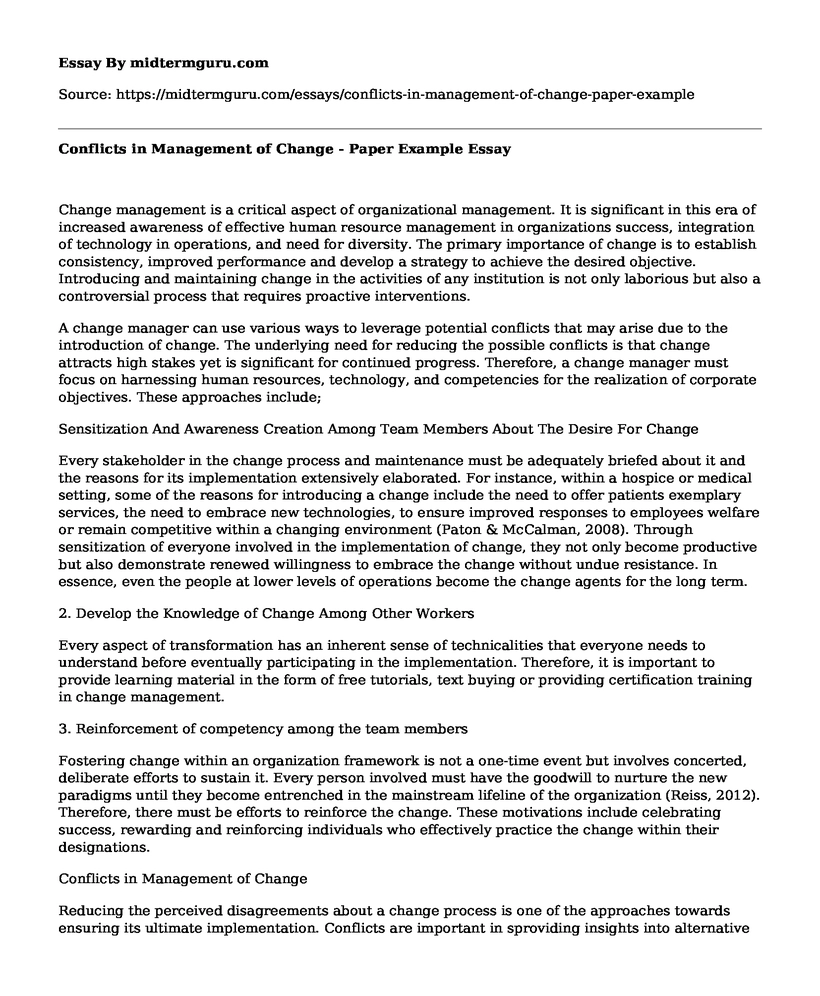Change management is a critical aspect of organizational management. It is significant in this era of increased awareness of effective human resource management in organizations success, integration of technology in operations, and need for diversity. The primary importance of change is to establish consistency, improved performance and develop a strategy to achieve the desired objective. Introducing and maintaining change in the activities of any institution is not only laborious but also a controversial process that requires proactive interventions.
A change manager can use various ways to leverage potential conflicts that may arise due to the introduction of change. The underlying need for reducing the possible conflicts is that change attracts high stakes yet is significant for continued progress. Therefore, a change manager must focus on harnessing human resources, technology, and competencies for the realization of corporate objectives. These approaches include;
Sensitization And Awareness Creation Among Team Members About The Desire For Change
Every stakeholder in the change process and maintenance must be adequately briefed about it and the reasons for its implementation extensively elaborated. For instance, within a hospice or medical setting, some of the reasons for introducing a change include the need to offer patients exemplary services, the need to embrace new technologies, to ensure improved responses to employees welfare or remain competitive within a changing environment (Paton & McCalman, 2008). Through sensitization of everyone involved in the implementation of change, they not only become productive but also demonstrate renewed willingness to embrace the change without undue resistance. In essence, even the people at lower levels of operations become the change agents for the long term.
2. Develop the Knowledge of Change Among Other Workers
Every aspect of transformation has an inherent sense of technicalities that everyone needs to understand before eventually participating in the implementation. Therefore, it is important to provide learning material in the form of free tutorials, text buying or providing certification training in change management.
3. Reinforcement of competency among the team members
Fostering change within an organization framework is not a one-time event but involves concerted, deliberate efforts to sustain it. Every person involved must have the goodwill to nurture the new paradigms until they become entrenched in the mainstream lifeline of the organization (Reiss, 2012). Therefore, there must be efforts to reinforce the change. These motivations include celebrating success, rewarding and reinforcing individuals who effectively practice the change within their designations.
Conflicts in Management of Change
Reducing the perceived disagreements about a change process is one of the approaches towards ensuring its ultimate implementation. Conflicts are important in sproviding insights into alternative ways of doing things and a trigger for people to come together and compromise big stakes but efforts must be towards orienting individual perceptions and ideas towards a common organizational goal (Reiss, 2012). Consultations and negotiations are some of the most practical ways of reaching an agreeable consensus among stakeholders. Ideally, consultations bestow upon every member the opportunity to be listened to which is a form of power distribution within the team (Peter, Robin & Alison, 2005). This distribution of authority leads to sustainable projects.
In the course of change introduction, implementation and sustenance, the role of a manager are to direct people towards the change process, provide the means of achieving the change and become an example of how it should be attained. The leader must be proficient in the practical application of tools of change (Reiss, 2012). In essence, the practice of change is more paramount than having so much knowledge about it. In this sense, the manager should embody the image of a master of change.
References
Paton, R. A., & McCalman, J. (2008). Change Management: A Guide to Effective Implementation. London: Sage Publications.
Peter H. Kim, Robin L. Pinkley & Alison R. Fragale (2005). Power Dynamics in Negotiation. Academy of Management Review, Vol. 30, No. 4, 799822.
Reiss, M. (2012). Change management: A balanced and blended approach. Norderstedt: Books on Demand.
Cite this page
Conflicts in Management of Change - Paper Example. (2021, Jun 03). Retrieved from https://midtermguru.com/essays/conflicts-in-management-of-change-paper-example
If you are the original author of this essay and no longer wish to have it published on the midtermguru.com website, please click below to request its removal:
- Dominos Pizza Company Analysis - Paper Example
- Paper Example on Leadership Decision Making
- What Is Going On With DHS in Strategic Sourcing? - Essay Sample
- Leadership Personality Traits - Essay Sample
- Developing Leaders Through Trait Theory: A Process of Education - Essay Sample
- Strategic Planning: Establishing Direction & Chaotic Strategies - Research Paper
- Making Professional Partnerships Work: Communication & Decision Making - Research Paper







